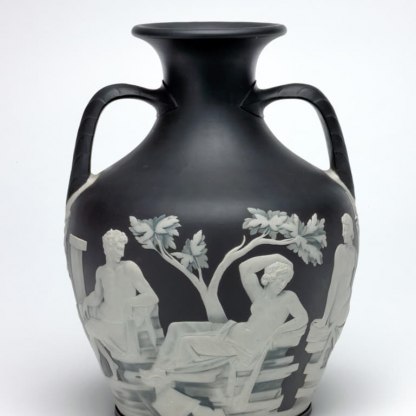Dish

This large dish – or 'charger' – was probably made as a display piece to celebrate a marriage. Though the couple depicted are not identified by any inscription, it is likely that they represent King Charles II of England and his 24-year-old bride, Catherine of Braganza, daughter of the king of Portugal. They were married in 1662, two years after the monarchy of England had been restored, and it is likely that dishes like this were made specifically for display in the houses of Royalists.
The couple are depicted in a charmingly naïve manner, with their egg-shaped heads, wide, round eyes and dotted eyebrows, her stylised curls and his distinctive, black ‘King Charles spaniel’ locks. But quaint as it may appear, the decoration is very sophisticated compared to much of the other slipware produced in the period and it demonstrates considerable skill, most notably in the white ‘jewelling’ of the figures' outlines and the details of Catherine’s hair.
Slipware is lead-glazed earthenware decorated with ‘slip’ – a sloppy mixture of clay and water. Here a cream slip covers the front surface of the plate, while darker slips are used for the decorative elements. These have been trailed across the surface of the vessel, rather like iced decorations upon a cake. This technique reached its peak in the seventeenth century in the potteries of Staffordshire, and much of the best work had Royalist imagery like that of the Fitzwilliam dish.
The name of Thomas Toft appears at the bottom in large, lively capital letters. Toft is today regarded as the most important producer of slipware pottery in seventeenth-century Staffordshire, but almost nothing is known of his life. Over thirty dishes carry his name, although some of these may have been made by his son, also called Thomas.
Themes and periods
Data from our collections database
Circular earthenware dish, decorated with slip and lead-glazed: busts of a man and woman surrounded by a trellis border broken by a panel enclosing the name, THOMAS.TOFT
Earthenware, thrown, the front coated with white slip, and slip-trailed in two shades of brown under lead-glaze; reverse unglazed. Circular with a broad rim, deep sides, and almost flat centre. Decorated in the middle with busts of a woman with her hair dressed in ringlets and wearing a necklace and a crown, and a man with a long wig, probably Catherine of Braganza and Charles I. Above and between their heads is a rosette, and below, a winged motif. The sides of the well are decorated with a zig-zag slightly curved line forming triangles, and the rim has a trellis border, broken at the bottom by a rectangular panel enclosing the name THOMAS.TOFT
J.E. Hodgkin Collection; Wilfred Harding, London from whom purchased on 13 or 15 September 1913 for £170 by Dr J.W.L. Glaisher, FRS, Trinity College, Cambridge. The dish arrived in Cambridge on 16 October.
Legal notes
Dr. J.W.L. Glaisher Bequest
Acquisition and important dates
- Method of acquisition: Bequeathed
- Dates: 1928-12-07
Dating
The couple on the dish may represent Charles II and his wife, Catherine of Braganza who were married in 1662, but the dish could have been made some years later. The slip-trailed trellis border is typical of these large dishes, but some examples have male heads, tulips, or rosette-like motifs.
Thomas Toft is the most famous of the seventeenth-century Staffordshire slipware potters, but very little is known about his life. He was probably the Thomas Toft who married in 1663, paid Hearth Tax at the village of Stanley in 1663, and 1666, and was buried at Stoke on 3 December 1689. Over thirty dishes bearing his name have been recorded but a few of them may have been made by his son, also Thomas Toft. What Toft senior made other than dishes is largely conjectural. Only four pieces of hollow ware bearing his name are known, among them a small jug in the Fitzwilliam Museum (C.1-1937).
Maker(s)
- Toft, Thomas Potter
Note
The couple on the dish may represent Charles II and his wife, Catherine of Braganza who were married in 1662, but the dish could have been made some years later. The slip-trailed trellis border is typical of these large dishes, but some examples have male heads, tulips, or rosette-like motifs.
Thomas Toft is the most famous of the seventeenth-century Staffordshire slipware potters, but very little is known about his life. He was probably the Thomas Toft who married in 1663, paid Hearth Tax at the village of Stanley in 1663, and 1666, and was buried at Stoke on 3 December 1689. Over thirty dishes bearing his name have been recorded but a few of them may have been made by his son, also Thomas Toft. What Toft senior made other than dishes is largely conjectural. Only four pieces of hollow ware bearing his name are known, among them a small jug in the Fitzwilliam Museum (C.1-1937).
Place(s) associated
- Staffordshire
Materials used in production
Read more about this recordOther highlight objects you might like
Suggested Curating Cambridge products
Sign up to our emails
Be the first to hear about our news, exhibitions, events and more…





